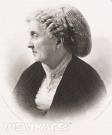Paulina Kellogg Wright Davis 1813 - 1876
February 06, 2008
 Paulina
Kellogg Wright
Davis 1813 - 1876
Paulina was a supporter of homeopathy and a close friend of homeopaths
and their supporters, including Ernestine
Rose,
Elizabeth Cady
Stanton,
Susan B
Anthony,
Angelina Grimke
Weld,
Antionette Brown
Blackwell and
Lucy
Stone,
Bronson
Alcott,
Ralph Waldo
Emerson,
Theodore Parker,
Margaret
Fuller,
Elizabeth
Peabody
and Caroline Wells Healey
Dall.
Paulina
Kellogg Wright
Davis 1813 - 1876
Paulina was a supporter of homeopathy and a close friend of homeopaths
and their supporters, including Ernestine
Rose,
Elizabeth Cady
Stanton,
Susan B
Anthony,
Angelina Grimke
Weld,
Antionette Brown
Blackwell and
Lucy
Stone,
Bronson
Alcott,
Ralph Waldo
Emerson,
Theodore Parker,
Margaret
Fuller,
Elizabeth
Peabody
and Caroline Wells Healey
Dall.
Paulina lectured widely on anatomy and physiology, hygeine and dress reform, and she was a disciple of *Sylvester Graham’s Hydropathic movement alongside Mary Gove Nichols. They both advocated birth control. Paulina published the magazine The Una.
As early as 1844 she began her lectures to women. She imported from Paris the first femme modele that was ever brought to this country, which she recently presented to ’The Homeopathic College for Women’ in New York.
The same year of the convention, the Married Woman’s Property Bill, which had given rise to some discussion on woman’s rights in New York, had passed the legislature. This encouraged action on the part of women, as the reflection naturally arose that, if the men who make the laws were ready for some onward step, surely the women themselves should express some interest in the legislation. Ernestine L. Rose, Paulina Wright (Davis), and I had spoken before committees of the legislature years before, demanding equal property rights for women.
Paulina’s house was a meeting place for many people, including Isabella Beecher Hooker, Harriet Beecher Stowe, Sarah Pugh, Elizabeth Cady Stanton and Susan B Anthony. Paulina called the first National Woman’s Rights Convention in 1850 and she was Vice President of the New England Woman Suffrage Association.
Paulina Kellogg was born in Bloomfield, New York, to Captain Ebenezer Kellogg and Polly Saxton. The family moved to the frontier near Niagara Falls in 1817. Both her parents died, and in 1820 she went to live with her orthodox Presbyterian aunt in Le Roy, New York. She joined the church, although she found it hostile to outspoken women. She wanted to become a missionary but was unable to as the church did not allow single women to become missionaries.
She was courted by suitor Francis Wright, a merchant from a prosperous family from Utica, New York; they married in 1833. They had similar values and both resigned from their church to protest its pro-slavery stance and served on the executive committee of the Central New York Anti-Slavery Society.
They also supported women’s rights reforms, associating with feminists Susan B. Anthony, Elizabeth Cady Stanton and Ernestine Rose. During this period Paulina Kellogg studied women’s health. Francis Wright died in 1845; the couple had no children.
Following her husband’s death she moved to New York to study medicine. In 1846 she gave lectures on anatomy and physiology to women only. She imported a medical mannequin and toured the eastern United States teaching women and urging them to become physicians.
In 1849 she married Thomas Davis, an Irish-American Democrat from Providence, Rhode Island; they adopted two daughters. In 1850 she started to focus her energies on women’s rights. She stopped lecturing and helped to arrange the 1850 National Women’s Rights convention. In 1853 she began editing the women’s newspaper The Una, which she edited till 1855 when she handed it over to Caroline Henry Dall.
In 1870 she arranged the twentieth anniversary of the Women’s Suffrage Movement meeting, and published the proceeds as The History of the National Woman’s Rights Movement.
Raised by a highly religious aunt after being orphaned at age seven, Davis eventually ran away from home and married Frances Wright, a wealthy local merchant, in 1833.
In 1840 Wright began collecting women’s signatures on a petition in support of the New York ”Married Woman’s Property Rights Bill.” Widowed in 1845, Davis was lecturing to women about women’s anatomy and physiology using a human model, an extremely controversial undertaking.
Married in 1849 to the like-minded — and soon to be Congressman Thomas Davis, Paulina Davis organized the 1850 first National Worcester Woman’s Rights Convention and served as Vice-President of the 1852 Syracuse National (Women’s Rights) Convention.
The wealthy Davis used some of her funds to publish the pro-suffrage journal, The Una (1853). Staunch supporter of Anthony and Stanton after the split in the woman’s rights movement following the Civil War, in 1868 Davis co-founded the New England Woman Suffrage Association and the Rhode Island Woman Suffrage Association. Thomas Davis carried on his wife’s work for 20 years after her death.
Paulina wrote Female Physicians, Boston Medical and Surgical Journal 41 (1849): 520-522, A History of the National Woman’s Rights Movement with Victoria Claflin Woodhull, A History of the National Woman’s Rights Movement, for Twenty Years with Victoria Claflin Woodhull.
Of interest:
Dr *Sylvester Graham (1794-1851) and the aforementioned William Alcott, editor of the Moral Reformer and the Library of Health. Both became presidents of the American Vegetarian Society.
Metcalfe converted Graham, inventor of graham bread and graham crackers, to vegetarianism. Graham was an enormous influence on John Harvey Kellogg. Kellogg was already a vegetarian but Graham’s views on diet turned Kellogg’s mind to food reform.
And the result of that concern is on most breakfast tables every day. Alcott converted his cousin, Bronson Alcott, to vegetarianism in 1835 and it was Bronson whose ideas inspired the Concordium community in Richmond. Influential in his day, Alcott’s fame was superseded by that of his daughter, Louisa May Alcott, who wrote Little Women.